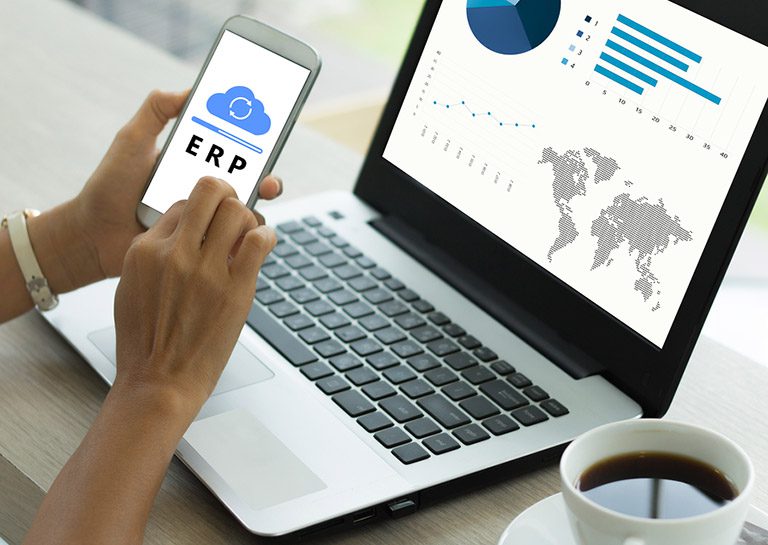Every day, businesses acquire more and more data through complex processes. An enterprise relationship planning (ERP) system integrates data in the backend, across human resources (HR), finance, distribution, manufacturing and other operations. It gives companies the power to easily secure, manage and transfer data between internal/external applications. For example, they can retrieve and analyze information from billing and details, purchase history, accounting and supply chain more easily.
While some ERP suites come with customer relation management (CRM) functionality built-in, they may be limited in capability or simply, the one-size-fits-all approach doesn’t work. Every company has their own unique requirements and scales up or down at varying paces. As this is often the case, many companies look to a separate CRM and ERP integration to solve these problems and to create their perfect suite.
As ERP enhances corporate data on the backend, a CRM system focuses on the front-facing side of the business. It can help you:
- Understand prospective and current clients
- Record interactions with customers
- Manage business pipelines
- Oversee prospecting
- Create and evaluate marketing campaigns
- Nurture relationships and sales opportunities
- Track sales
- Upsell and cross-sell products
Now, let’s learn about the benefits of integrating these two systems together.
The Unique Benefits of CRM and ERP Integration
When you integrate your CRM and ERP systems together, you will see an abundance of benefits that will lead you down the path of improving critical business processes, enhancing workplace culture, improving transparency, generating accurate reporting and more. Your business will see the following benefits after syncing their technologies into one.

Remove manual inefficiencies, ensure data accuracy
When you employ two separate systems, the only way to transfer the data from one to the other is by manual means. Human error can be accounted for hiccups in business operations that can sway time, focus and other resources trying to fix them. When you’re centered on fixing easily by-passable issues, your production can dip, and employee wellbeing can fade which all directly affect you bottom line.
Through CRM and ERP integration, rules can be established that enforce automated updated in like-fields across your systems. For example, if you updated some notes under a client in your CRM, you would then expect to be able to see those notes update in any other instance in your ERP suite where that client appears in.
Automated efficiencies implemented prevent human hands from touching the data. This ensuring data is always accurate, allowing your business to generate accurate reporting to enhance processes, and to ensure government compliance is met.
Obtain a transparent viewpoint of your clientele
As your leads funnel down into first customers, then into loyal buyers; every interaction, question, demo viewed, purchase and more is recorded within your CRM and ERP systems. Over time, you can gather a ton of valuable data on your customers to further enhance their experience with you.
Imagine that your best clients continue to tell you over a period that your company is missing an essential product that they must buy from another vendor. This gives you an opportunity to create a new, in-demand product offering, as well as solve a few pain points for these clients.
- The communications, ordering process, customer service calls, etc. are all streamlined to just one vendor, rather than two. It saves your clients time that could be better used elsewhere.
- In many cases, they can typically save more costs going through one vendor, thus, saving them money.
- Based off compiled client data, your business can develop the perfect product offering they demand.
As you address pain points and provide focused-services to your clients, you’ll build long-lasting relationships that propel your business forward. With accurate data used correctly, you streamline how you track developments in client pain points, preferences, history, loyalty and more.
Streamline quoting, ordering, inventory, etc. with CRM and ERP integration
There is nothing streamlined or efficient about transferring data from one system to another. What’s constructive about manually obtaining data, then re-keying it into another tool? When your business integrates its CRM within an ERP environment, new automated efficiencies can improve operations immensely.

For example, you can take sales proposals, created in the CRM, and turn them into purchase orders. These steps are finalized and transferred on the backend, with the ERP. As these steps are all performed in one, integrated system, the speed of the data works increases and is automated. This allows you to ensure accurate data and faster finish times on processing.
In vice versa, someone from sales would be able to obtain ERP-based data within the CRM to quickly provided up-to-date pricing information to a client they are working with for example.
What’s that saying? Speed kills?
How fast you communicate to a potential or current client can be the difference of either making or missing sales.
Who can Benefit from CRM and ERP Integration?
The following stakeholders all benefit when CRM and ERP are properly integrated, working as one finely, well-oiled machine. Those stakeholders include:
Customers—Your clients win because of the on-going efforts by your business to enhance communication, the relationship, product offerings and more. As data compiles over time, you’ll be able to improve the experience and relationship exponentially. The insights you find from their purchase history, calls, questions and other interactions will enable you to potentially know more about them than they do themselves.
Administrators—This group wins with the integration due to them shedding responsibilities that once were manual. With properly set up workflows, data accuracy is ensured, information is secure and compliance is easily met.
Sales representatives—This group can commandeer data from CRM and ERP to oversee how campaigns are doing, as well as keep on top of which products are selling best and why. With data combined into one system, sales can forecast product demand, inquire on customer interactions, provide solutions that their clients didn’t know they needed and more.
Manufacturers—While this group may not be so concerned about the sales side of operations, with combined CRM and ERP integration, these tools help to boost communication and relationships between them, sales, shop floor operations, corporate and more. If shipments need to be rushed, manufacturing can access accurate shipping dates to plan for what needs to prioritized for production.
Businesses—And of course, companies obviously benefit when their critical CRM and ERP information is integrated to into one system. When data is secure, compliant and easily manageable, it affects all stakeholders positively. Integrated tools make the jobs easier for administrators, sales people, manufacturers and more with automated workflows. Communication is enhanced, performance increases, a path is identified, and actionable decision-making becomes easy to do. In turn, customers purchase more which puts more revenue into the businesses’ pockets.
With CRM and ERP integrated into one system, the affects can positively affect all stakeholders in full circle.
Enhance ERP with HR Automated Solutions from the Cloud-Based Arcoro Platform
Like with CRM and ERP integration, not all ERP systems are built with dedicated human capital management (HCM) modules to oversee HR management, talent management and payroll processes. You may be able to get away with using some ERP tools to manage a few HR processes, but you’ll quickly realize these tools are not flexible when your requirements demand that your business scale.

The cloud-based Arcoro platform features 10 modules that can be implemented separately, or as the entire platform suite. It’s features a built-in integration with over 300 partners, including to ERP systems, top-of-class insurance carriers, payroll systems, HRMS, business intelligence, CRM, HRIS, drug and screening vendors, job boards and much more.
Arcoro cloud-based modular solutions
The platform features the following HR automated solutions:
- Core HR—featuring employee self-service tools
- Benefits Management
- ACA Compliance
- Time and Attendance
- Payroll Processing
- Applicant Tracking System
- Onboarding
- Performance Management
- Learning Management
- Succession Planning




